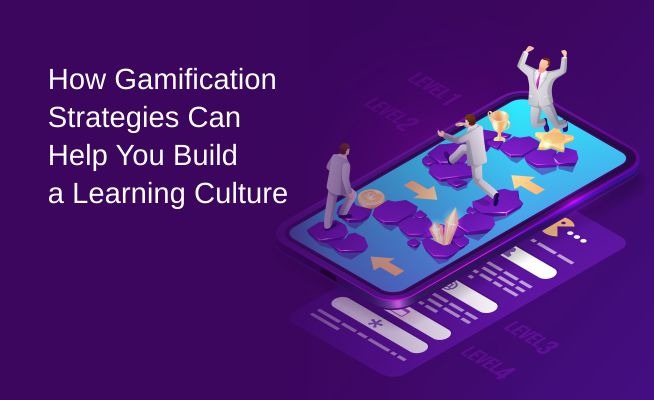
How Gamification Strategies Can Help You Build a Learning Culture
As we continue to adapt to a quickly changing environment, we are also confronted with new and increasing job difficulties that often need sophisticated answers. ’We are dealing with a decreasing talent pool to address our skill shortages or employment needs as the ‘Great Resignation’ takes its toll. And, as the saying goes, ‘when the hiring process becomes too difficult, training must take over’. In this article, we will look at how you can use gamification to upskill and reskill your employees, as well as how it can help you improve business KPIs, boost productivity, and boost employee contentment.
Why should your company leverage on gamification for upskilling and reskilling?
These are effective techniques for avoiding a skill shortage that is projected to persist. The digital tide and technological advancements are causing more and more job displacement, while new positions are being created at an exponential rate. We also have abilities in a variety of different areas that needs to be renewed. As the need for new competencies and skill sets rises, reskilling and upskilling may help your company recruit and retain top personnel while riding out the storm. If you work in learning and development, you are probably already acquainted with this, but if you’re not, let us take you through the journey of reskilling and upskilling.
What is gamification?
Gamification is the use of game-playing elements such as point scoring and competition in non-game activities. Other elements, like scoreboards and leader boards, may be provided to enable social interactions and emphasize competitive aspects. It is used to promote participation, enjoyment, and even fun in learning activities and training. Gamification should be used to combat tedious training.
These gamification strategies help you create a learning culture.
Games may help your company’s culture by providing a less intimidating learning environment in which to develop skills or even chart new career paths. It is a solution for you to meet the demands of a changing workforce and address problems without the additional time and money that recruiting would entail. In that light, consider the following gamification strategies to upskill and reskill your workforce.
Development of leadership
Use games to present material in a non-judgmental style that encourages people to want to learn and develop their hard and soft abilities. You may also assign these as a learning module and assessment because they are compatible with your LMS. With a variety of media alternatives and opportunities to study more, they may continue their education.
Leveling up
Training new hires might be difficult at times, but gamification can assist. Rather than burdening new employees with months of ineffective and complex onboarding, the whole training program may be segmented into tiers. Employees can be awarded for moving to the next level as they finish each level. As a result, new recruits are far more inclined to invest in the training process, which helps them to learn new skills. Receiving someone up to speed faster also means you are getting a greater return on investment from the onboarding process because you are not spending important work hours bringing someone up to speed slowly.
Changes, promotions, and rollouts
Situation learning is no longer limited to hands-on training, and games may help make it even more enjoyable and instructive experience. Create hot zones on a picture for the correct answer using image mapping features, while also addressing your visual and kinesthetic learners. Alternatively, you might use a polling option during your presentation to poll your team regarding the ideal brand for your new rollout or promotion.
Case-by-case
Employees nowadays want to know how they can advance and grow, and if they are provided a clear route to do so, they are significantly more likely to stay. What better way to keep it interesting and fun than with games? Create many technical knowledge assessments that they may access at any time to ‘raise their game.’
Data-driven sessions
Use a game to do a competency check-in or as ‘homework’ before a training session to conduct a knowledge check that will guide your future time together. Use the statistics provided by these games to go back and review or remediate as needed and deliver that feedback to your student so they may continue their learning.
Quizzes
Meetings can become a little tedious and monotonous if it is not interactive. Meetings should be turned into weekly quizzes. Engage everyone in the game and discover who has the most up-to-date information on work issues. Consider a trophy or perhaps a monetary incentive for the greatest performance. Employees will soon be looking forward to the next gathering. This encourages healthy competition and keeps everyone well prepared.
Make your work mission-driven
One of the most significant advantages of gamification is the ability to enhance team-building through genuine team-based exercises. When allocating tasks, create a friendly competition among teams to encourage higher performance. Instead of assigning teams to projects, assign them to missions that must be completed on time. You can instill a feeling of adventure in every piece of work by making it mission-based.
Check out our webinar on gamification: Gamification Strategies to Upskill & Reskill your Hybrid Workforce
In Conclusion
Keep in mind the generation gap. It is true that only around one-third of Gen X and Baby Boomers feel obligated to improve their skills in order to advance in their careers or maintain their positions. However, more than half of Millennials and Gen Z recognise the need of improving their skills and knowledge for professional success.
For this reason, continual learning efforts are more essential to them than other perks and rewards. Employers should think about retention as an advantage. Training is less expensive than replacing employees. To summarize, gamification is a crucial component of reskilling and upskilling success.






No Comments